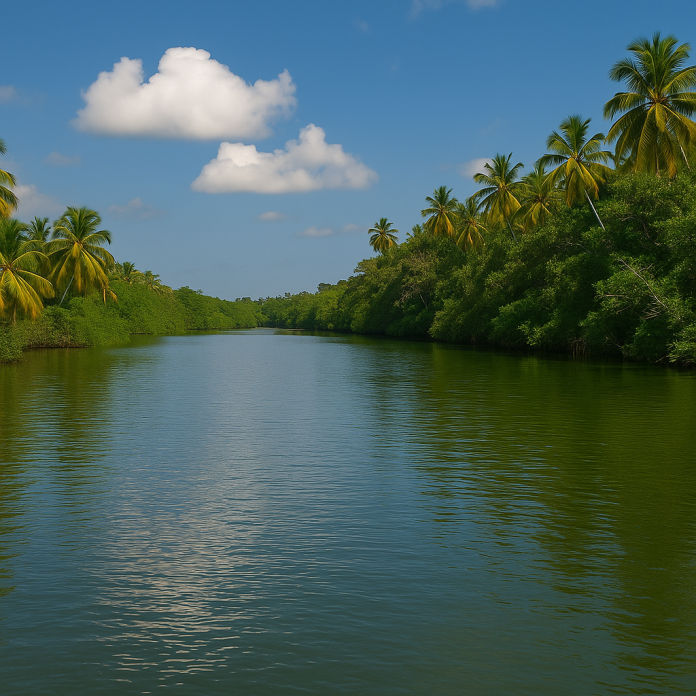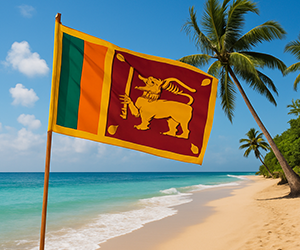Introduction to Madhu River
The Madhu River (also spelled Madu Ganga) is one of the most scenic and biodiverse waterways in Sri Lanka, winding its way through mangrove forests, coastal wetlands, and traditional villages before reaching the Indian Ocean near Balapitiya, along the southwest coast. Known for its ecological richness, spiritual landmarks, and tranquil boat safaris, the Madhu River has become a popular destination for eco-tourists and cultural explorers alike.
This article offers a comprehensive 4000-word guide to Madhu River, including its environmental significance, must-visit islands, cultural highlights, wildlife, and tips for an unforgettable visit.
Geography and Ecosystem
The Madhu River is located in Galle District and flows through the towns of Balapitiya, Ambalangoda, and Kosgoda. The river is about 15 km long and connects to a complex estuary and lagoon system. It supports over 15 islands, more than 300 plant species, and a wide array of birds, fish, and reptiles.
It is one of the few remaining mangrove ecosystems in Sri Lanka and was declared a Ramsar Wetland Site in recognition of its international ecological importance.
The Cultural and Spiritual Value
Madhu River is not only a natural wonder but also a cultural treasure. The river is dotted with ancient temples, monasteries, and Buddhist shrines that date back centuries. Monks live in seclusion on some of the islands, continuing age-old traditions.
One of the most prominent spiritual sites is the Kothduwa Raja Maha Viharaya, a Buddhist temple said to have sheltered a sapling from the sacred Sri Maha Bodhi tree.
Popular Attractions and Islands
1. Kothduwa Temple (Kothduwa Raja Maha Viharaya)
This island temple is accessible only by boat. Visitors are welcomed with incense, quiet chanting, and stunning views. Monks live here and maintain the sacred Bodhi tree.
2. Cinnamon Island
Tourists can observe the traditional cinnamon peeling process and even try a taste of freshly brewed cinnamon tea. It’s a great place to learn about one of Sri Lanka’s most prized exports.
3. Bird Island
This protected area is home to various species of water birds, including herons, egrets, and kingfishers. Early morning is the best time to spot wildlife.
4. Fish Therapy Stations
Several floating platforms offer a quirky experience: natural foot massage from tiny fish that nibble on dead skin. A favorite among curious visitors!
5. Mangrove Forest Tunnels
Drifting through these natural green tunnels formed by arching mangrove roots is a peaceful and photogenic highlight of the Madhu River safari.
Madhu River Safari Experience
The best way to explore Madhu River is by taking a boat safari from Balapitiya. Most tours last 1.5 to 2 hours, covering multiple islands and points of interest.
What to expect on a safari:
- Experienced local guide
- Stops at temples, islands, and spice gardens
- Photo opportunities with wildlife
- Cultural demonstrations (cinnamon processing, mask carving)
Biodiversity and Wildlife
Madhu River is a sanctuary for hundreds of species, including:
Birds:
- Kingfishers
- Cormorants
- Purple Herons
- Brahminy Kites
Reptiles and Amphibians:
- Monitor Lizards
- Water Snakes
- Frogs and Toads
Mammals:
- Monkeys
- Bats
- Occasional sightings of wild boars
Aquatic life:
- Shrimp and crabs
- Small fish species
- Mangrove oysters
Environmental Importance
The mangrove forests of the Madhu River act as a natural barrier against coastal erosion and tsunamis. They also serve as breeding grounds for marine life, playing a vital role in local fisheries.
Conservation efforts have focused on:
- Mangrove reforestation
- Eco-tourism development
- Community education programs
Visitors are encouraged to travel responsibly by avoiding plastic, supporting eco-friendly tour operators, and respecting wildlife.
History of Madhu River
Historically, Madhu River was a thriving waterway for cinnamon trade and transport during the Dutch and Portuguese colonial periods. Its estuary allowed small boats to carry spices to the coast, making it an integral part of Sri Lanka’s maritime heritage.
Culinary Experiences
Visitors can enjoy Sri Lankan seafood at riverside restaurants or during lunch breaks on boat tours. Must-try dishes include:
- Fresh prawn curry
- Crab with coconut sambol
- Rice and curry with river fish
Some tours also offer cooking demonstrations on island homes, giving tourists a taste of authentic local life.
Local Communities and Culture
The communities along Madhu River are known for:
- Cinnamon farming
- Mask carving and puppet shows (especially in nearby Ambalangoda)
- Traditional fishing and boat-building
Tourists can support local families by purchasing handicrafts and participating in cultural exchanges.
Best Time to Visit
The best time to visit Madhu River is during the dry season (November to April). During this period, the skies are clear, wildlife is active, and boat rides are smoother.
Getting There
Madhu River is easily accessible from major tourist hubs:
- Colombo to Balapitiya: Approx. 2 hours by car
- Galle to Balapitiya: Approx. 1 hour by car
- Bentota to Balapitiya: Approx. 30 minutes by tuk-tuk or taxi
Train services also connect Colombo and Galle to Ambalangoda station, just a few kilometers from Balapitiya.
Where to Stay Nearby
- Heritance Ahungalla – Luxury beachfront resort
- River House by Asia Leisure – Upscale riverside boutique hotel
- Roman Lake – Mid-range stay with eco-friendly amenities
- Budget guesthouses in Ambalangoda and Kosgoda
Travel Tips
- Carry sun protection (hats, sunscreen)
- Wear light clothing and insect repellent
- Avoid feeding animals or disturbing birds
- Keep your camera ready during mangrove sections
- Bring small cash for donations or purchases
Responsible Tourism Guidelines
- Choose certified eco-tour operators
- Refrain from using single-use plastics
- Respect local customs and religious sites
- Do not touch or remove plants or animals
- Support local businesses and guides




